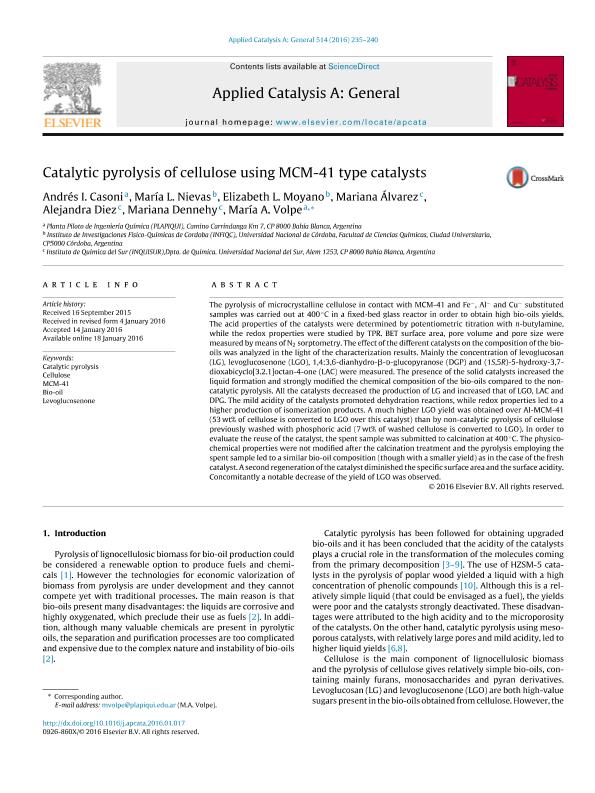Mostrar el registro sencillo del ítem
dc.contributor.author
Casoni, Andrés Iván

dc.contributor.author
Nieva, María Luz

dc.contributor.author
Moyano, Elizabeth Laura

dc.contributor.author
Alvarez, Mariana

dc.contributor.author
Diez, Alejandra

dc.contributor.author
Dennehy, Mariana

dc.contributor.author
Volpe, María Alicia

dc.date.available
2017-10-03T16:44:39Z
dc.date.issued
2016-01
dc.identifier.citation
Casoni, Andrés Iván; Nieva, María Luz; Moyano, Elizabeth Laura; Alvarez, Mariana; Diez, Alejandra; et al.; Catalytic pyrolysis of cellulose employing MCM-41 type catalysts; Elsevier Science; Applied Catalysis A: General; 514; 1-2016; 235-240
dc.identifier.issn
0926-860X
dc.identifier.uri
http://hdl.handle.net/11336/25747
dc.description.abstract
The pyrolysis of microcrystalline cellulose in contact with MCM-41 and Fe−, Al− and Cu− substituted samples was carried out at 400◦C in a fixed-bed glass reactor in order to obtain high bio-oils yields.The acid properties of the catalysts were determined by potentiometric titration with n-butylamine,while the redox properties were studied by TPR. BET surface area, pore volume and pore size were measured by means of N2 sorptometry. The effect of the different catalysts on the composition of the bio-oils was analyzed in the light of the characterization results. Mainly the concentration of levoglucosan(LG), levoglucosenone (LGO), 1,4:3,6-dianhydrogo-B-D-glucopyranose (DGP) and (1S,5R)-5-hydroxy-3,7-dioxabicyclo[3.2.1]octan-4-one (LAC) were measured. The presence of the solid catalysts increased theliquid formation and strongly modified the chemical composition of the bio-oils compared to the non-catalytic pyrolysis. All the catalysts decreased the production of LG and increased that of LGO, LAC and DPG. The mild acidity of the catalysts promoted dehydration reactions, while redox properties led to ahigher production of isomerization products. A much higher LGO yield was obtained over Al-MCM-41(53 wt% of cellulose is converted to LGO over this catalyst) than by non-catalytic pyrolysis of cellulose previously washed with phosphoric acid (7 wt% of washed cellulose is converted to LGO). In order to evaluate the reuse of the catalyst, the spent sample was submitted to calcination at 400◦C. The physico-chemical properties were not modified after the calcination treatment and the pyrolysis employing the spent sample led to a similar bio-oil composition (though with a smaller yield) as in the case of the fresh catalyst. A second regeneration of the catalyst diminished the specific surface area and the surface acidity.Concomitantly a notable decrease of the yield of LGO was observed.
dc.format
application/pdf
dc.language.iso
eng
dc.publisher
Elsevier Science

dc.rights
info:eu-repo/semantics/openAccess
dc.rights.uri
https://creativecommons.org/licenses/by-nc-sa/2.5/ar/
dc.subject
Catalytic Pyrolysis
dc.subject
Cellulose
dc.subject
Mcm-41
dc.subject
Bio-Oil
dc.subject
Levoglucosenone
dc.subject.classification
Otras Ciencias Químicas

dc.subject.classification
Ciencias Químicas

dc.subject.classification
CIENCIAS NATURALES Y EXACTAS

dc.title
Catalytic pyrolysis of cellulose employing MCM-41 type catalysts
dc.type
info:eu-repo/semantics/article
dc.type
info:ar-repo/semantics/artículo
dc.type
info:eu-repo/semantics/publishedVersion
dc.date.updated
2017-09-25T18:12:13Z
dc.journal.volume
514
dc.journal.pagination
235-240
dc.journal.pais
Países Bajos

dc.journal.ciudad
Amsterdam
dc.description.fil
Fil: Casoni, Andrés Iván. Consejo Nacional de Investigaciones Científicas y Técnicas. Centro Científico Tecnológico Conicet - Bahía Blanca. Planta Piloto de Ingeniería Química. Universidad Nacional del Sur. Planta Piloto de Ingeniería Química; Argentina
dc.description.fil
Fil: Nieva, María Luz. Consejo Nacional de Investigaciones Científicas y Técnicas. Centro Científico Tecnológico Conicet - Córdoba. Instituto de Investigaciones en Físico-química de Córdoba. Universidad Nacional de Córdoba. Facultad de Ciencias Químicas. Instituto de Investigaciones en Físico-química de Córdoba; Argentina
dc.description.fil
Fil: Moyano, Elizabeth Laura. Consejo Nacional de Investigaciones Científicas y Técnicas. Centro Científico Tecnológico Conicet - Córdoba. Instituto de Investigaciones en Físico-química de Córdoba. Universidad Nacional de Córdoba. Facultad de Ciencias Químicas. Instituto de Investigaciones en Físico-química de Córdoba; Argentina
dc.description.fil
Fil: Alvarez, Mariana. Consejo Nacional de Investigaciones Científicas y Técnicas. Centro Científico Tecnológico Conicet - Bahía Blanca. Instituto de Química del Sur. Universidad Nacional del Sur. Departamento de Química. Instituto de Química del Sur; Argentina
dc.description.fil
Fil: Diez, Alejandra. Consejo Nacional de Investigaciones Científicas y Técnicas. Centro Científico Tecnológico Conicet - Bahía Blanca. Instituto de Química del Sur. Universidad Nacional del Sur. Departamento de Química. Instituto de Química del Sur; Argentina
dc.description.fil
Fil: Dennehy, Mariana. Consejo Nacional de Investigaciones Científicas y Técnicas. Centro Científico Tecnológico Conicet - Bahía Blanca. Instituto de Química del Sur. Universidad Nacional del Sur. Departamento de Química. Instituto de Química del Sur; Argentina
dc.description.fil
Fil: Volpe, María Alicia. Consejo Nacional de Investigaciones Científicas y Técnicas. Centro Científico Tecnológico Conicet - Bahía Blanca. Planta Piloto de Ingeniería Química. Universidad Nacional del Sur. Planta Piloto de Ingeniería Química; Argentina
dc.journal.title
Applied Catalysis A: General

dc.relation.alternativeid
info:eu-repo/semantics/altIdentifier/doi/http://dx.doi.org/10.1016/j.apcata.2016.01.017
dc.relation.alternativeid
info:eu-repo/semantics/altIdentifier/url/http://www.sciencedirect.com/science/article/pii/S0926860X16300175
Archivos asociados
